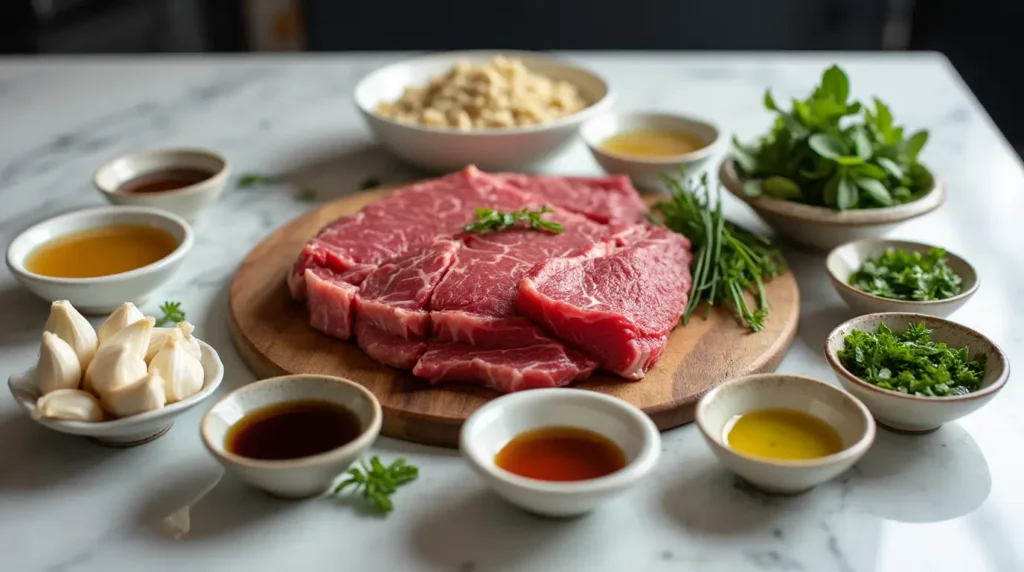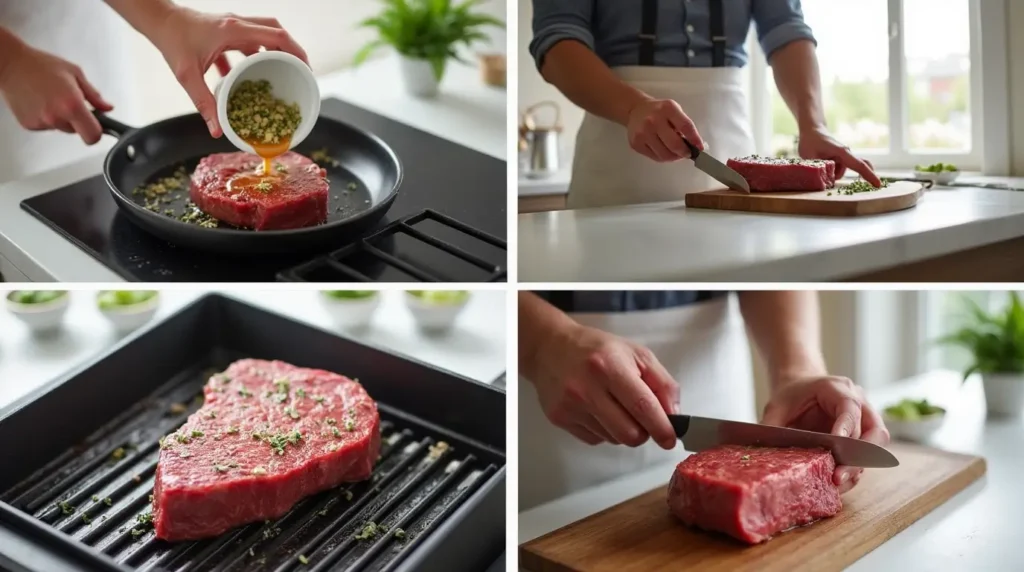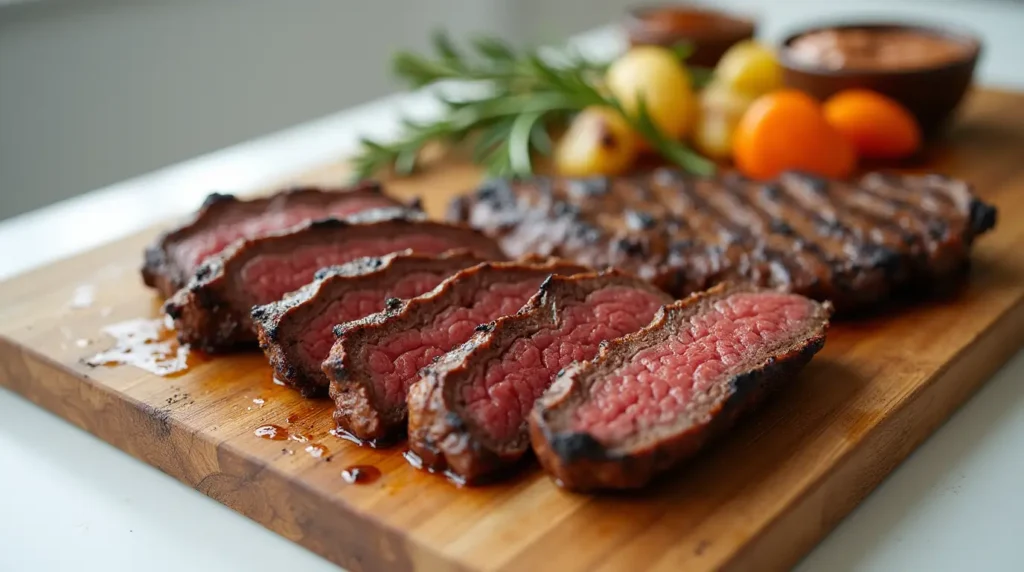Introduction
Have you ever wondered how some home cooks consistently create mouthwatering steak dishes that rival expensive steakhouses? The secret might be simpler than you think, and it begins with choosing the right cut. After years of experimenting with different cuts and techniques, I’ve fallen in love with beef flap steak—an underrated cut that delivers incredible flavor without breaking the bank.
Let me tell you a secret: I tried cooking beef flap steak seven different ways before landing on the methods I’m sharing today. There were some memorable disasters (like the time I set off every smoke alarm in the house during my husband’s birthday dinner!), but these trials led to the foolproof beef flap steak recipes that have become staples in my household.
Table of Contents
Ingredients List

For the Classic Marinated Flap Steak:
- 2 pounds beef flap steak (sometimes labeled as sirloin flap or bavette steak)
- 3 tablespoons olive oil
- 4 garlic cloves, minced
- 2 tablespoons fresh rosemary, chopped
- 2 tablespoons fresh thyme leaves
- 1 tablespoon Dijon mustard
- 1 tablespoon Worcestershire sauce
- 1 teaspoon sea salt (I use the flaky sea salt I discovered at a little market in Maine last summer)
- 1 teaspoon freshly ground black pepper
I always try to source my beef flap steak from the local butcher down the street rather than the supermarket. The quality difference is noticeable, and Joe (my butcher) always cuts it to the perfect thickness. If you can’t find beef flap steak, flank steak or skirt steak will work, though they’re not quite as tender when cooked right.
The aromatics are crucial here—when you combine the garlic with fresh herbs, you’ll notice this incredible earthy, vibrant fragrance that signals good things are coming to your dinner table. I grow rosemary and thyme in pots on my kitchen windowsill, which makes a world of difference compared to the dried versions.
For the Asian-Inspired Flap Steak:
- 2 pounds beef flap steak
- ¼ cup reduced-sodium soy sauce
- 2 tablespoons honey
- 2 tablespoons rice vinegar
- 2 tablespoons sesame oil
- 3 garlic cloves, minced
- 1 tablespoon fresh ginger, grated
- 2 green onions, thinly sliced
- 1 teaspoon red pepper flakes (adjust to your spice preference)
My kids go absolutely wild for this version. The first time I made it, my usually picky 10-year-old asked for seconds—a miracle in our household! The balance of sweet, salty, and umami flavors works perfectly with the rich beef flap steak.
Timing
Classic Marinated Flap Steak:
- Preparation time: 15 minutes
- Marinating time: 2-24 hours (I usually prep this the night before or in the morning before work)
- Cooking time: 10-12 minutes
- Total time: 2 hours 30 minutes (including minimum marinating time)
I’ve found that marinating overnight truly develops the deepest flavor, but even a quick 2-hour marinade works wonders when you’re short on time. This recipe is my go-to for Thursday nights when the kids have soccer practice, and I need something impressive but easy to pull together.
Asian-Inspired Flap Steak:
- Preparation time: 15 minutes
- Marinating time: 1-4 hours
- Cooking time: 10-12 minutes
- Total time: 1 hour 30 minutes (including minimum marinating time)
This version doesn’t need quite as long to marinate, which makes it perfect for those days when dinner inspiration strikes late. I often prep the marinade while my kids are at school, then just throw everything together when I get home from work.
Step-by-Step Instructions

Classic Marinated Flap Steak
Step 1: Prepare the Marinade
Combine olive oil, minced garlic, chopped rosemary, thyme leaves, Dijon mustard, Worcestershire sauce, sea salt, and black pepper in a bowl. Whisk until well blended.
The first time I made this marinade, I tossed everything in without mixing it thoroughly, and the result was patches of overly seasoned steak alongside bland areas. Trust me, taking an extra minute to properly emulsify the marinade makes all the difference!
Step 2: Marinate the Steak
Place the beef flap steak in a large resealable plastic bag or shallow dish. Pour the marinade over the steak, ensuring it’s evenly coated. Seal the bag or cover the dish and refrigerate for at least 2 hours or overnight.
I learned a neat trick from my aunt in Texas: gently massage the marinade into the meat before refrigerating. This helps it penetrate deeper and ensures every bite is packed with flavor.
Step 3: Bring to Room Temperature
Remove the marinated steak from the refrigerator about 30 minutes before cooking to allow it to come to room temperature.
Skipping this step was my biggest rookie mistake when I first started cooking beef flap steak recipes. Cold meat hitting a hot pan results in uneven cooking and can make the outside char before the inside reaches the perfect temperature.
Step 4: Preheat Your Cooking Surface
Heat a cast-iron skillet over high heat until it’s smoking hot, or preheat your grill to high.
I inherited my grandmother’s cast-iron skillet, and it’s probably the most treasured item in my kitchen. There’s something almost magical about the way it sears meat—creating that perfect crust while keeping the inside juicy.
Step 5: Cook the Steak
Remove the steak from the marinade and pat dry with paper towels. This is important—too much moisture will prevent proper searing.
Place the steak on the hot skillet or grill. For medium-rare (my family’s preference), cook for about 4-5 minutes on each side. Adjust the time based on thickness and desired doneness.
The first time I cooked flap steak, I was so nervous about overcooking that I kept lifting it to check the underside. Big mistake! Let it be for at least 3-4 minutes to develop that beautiful crust. Patience is key here.
Step 6: Rest the Steak
Transfer the cooked steak to a cutting board and let it rest for 5-10 minutes before slicing. This allows the juices to redistribute throughout the meat.
I cannot stress this enough: resting your steak is non-negotiable! I used to skip this step until my neighbor (a professional chef) caught me in the act and staged an intervention. The difference in juiciness is remarkable.
Step 7: Slice Against the Grain
Look carefully at the beef flap steak to identify the direction of the meat fibers, then slice thinly against the grain for maximum tenderness.
Asian-Inspired Flap Steak
Step 1: Prepare the Marinade
In a bowl, combine soy sauce, honey, rice vinegar, sesame oil, minced garlic, grated ginger, sliced green onions, and red pepper flakes. Whisk until honey is fully dissolved.
My oldest daughter loves helping with this marinade—the aromas are so wonderful that she says it’s like “a vacation for your nose.” We always make extra to use as a dipping sauce later!
Step 2: Marinate the Steak
Place the beef flap steak in a large resealable plastic bag or shallow dish. Pour the marinade over the steak, ensuring it’s evenly coated. Seal the bag or cover the dish and refrigerate for 1-4 hours.
This marinade is stronger than the classic version, so I don’t recommend marinating overnight as it can overwhelm the natural flavor of the beef.
Step 3: Follow Steps 3-7 from the Classic Recipe
Continue with bringing the steak to room temperature, preheating your cooking surface, cooking the steak, resting it, and slicing against the grain as directed above.
For an extra flourish, I like to reduce the remaining marinade in a small saucepan until it thickens slightly, then drizzle it over the sliced steak just before serving. Just remember to bring the marinade to a full boil since it was in contact with raw meat.
Nutritional Information
Understanding the nutritional profile of what we’re eating is important to me as a mom trying to keep my family healthy. Here’s a breakdown for a typical 6-ounce serving of beef flap steak prepared with the classic marinade:
- Calories: 350
- Protein: 40g
- Fat: 20g (7g saturated)
- Carbohydrates: 2g
- Sodium: 580mg
- Iron: 15% DV
- Zinc: 35% DV
What I love about beef flap steak is the excellent protein content. As someone who stays active with morning yoga and weekend hiking, I appreciate that this cut provides substantial protein while being leaner than many alternative cuts.
The Asian-inspired version has a slightly different profile due to the honey and soy sauce:
- Calories: 370
- Protein: 40g
- Fat: 20g (7g saturated)
- Carbohydrates: 8g
- Sodium: 850mg
- Iron: 15% DV
- Zinc: 35% DV
I always try to balance these protein-rich meals with plenty of vegetables on the side to create a complete nutritional package.
Healthier Alternatives for the Recipe
While these beef flap steak recipes are already relatively healthy, there are several ways to make them even more nutritious:
For the Classic Marinade:
- Reduce the olive oil to 1 tablespoon and add 2 tablespoons of fresh lemon juice for brightness with fewer calories
- Use a sodium-free herb blend instead of salt if you’re watching sodium intake
- Add antioxidant-rich spices like paprika or turmeric for additional health benefits
For the Asian-Inspired Marinade:
- Substitute monk fruit sweetener for honey to reduce carbohydrates
- Use coconut aminos instead of soy sauce for a lower-sodium, gluten-free option
- Add finely shredded carrots or bell peppers to the marinade for additional nutrients
My sister-in-law follows a keto diet and introduced me to several of these swaps. The coconut aminos was a game-changer for us—it has a similar umami quality but with a slightly sweeter profile that works beautifully with the beef flap steak.
Remember that portion control is also key. A 4-ounce serving of beef flap steak provides plenty of protein while keeping calories in check. I’ve found that slicing the steak thinly and serving it with abundant vegetables makes for a satisfying meal that doesn’t leave anyone feeling deprived.
Serving Suggestions

For the Classic Marinated Flap Steak:
- Roasted fingerling potatoes with rosemary (echoing the flavors in the marinade)
- Grilled asparagus drizzled with lemon juice and olive oil
- Simple arugula salad with shaved Parmesan and balsamic glaze
- Crusty whole-grain bread to soak up the delicious juices
This is the meal I prepare for our family’s monthly Sunday dinner tradition. When my parents come over, my dad always positions himself strategically near the kitchen to sneak pieces of steak while I’m slicing it—some things never change, no matter how old we get!
For the Asian-Inspired Flap Steak:
- Coconut rice with a touch of lime zest
- Stir-fried bok choy with ginger and garlic
- Quick-pickled cucumber salad with rice vinegar and sesame seeds
- Steamed edamame with flaky sea salt
Last summer, I served this exact menu for my daughter’s high school graduation party. Her friends were so impressed that three of them asked for the recipe before leaving! There’s something so rewarding about introducing young people to home cooking that rivals takeout.
For a fun, interactive family dinner, I sometimes set up a “build-your-own” rice bowl station with the sliced steak, various vegetables, sauces, and toppings. My kids love the autonomy of creating their own meals, and I love that they’re more likely to try new vegetables this way.
Common Mistakes to Avoid
After years of cooking beef flap steak recipes (and making plenty of mistakes along the way!), here are the pitfalls I urge you to avoid:
1. Overcooking the Steak
Beef flap steak is at its most tender when cooked to medium-rare or medium. Going beyond that will result in tough, chewy meat. I learned this the hard way during a dinner party when I got distracted by a guest’s story and left the steak on the grill too long. We ended up with something closer to beef jerky than the succulent steak I’d promised!
2. Not Slicing Against the Grain
This is crucial for flap steak. Cutting with the grain results in chewy pieces that are difficult to eat. I once served incorrectly sliced flap steak to my in-laws and watched in horror as everyone politely struggled through dinner. Now I make a point of finding the grain direction before I start slicing.
3. Skipping the Resting Period
I know it’s tempting to dig in right away, but allowing your steak to rest for 5-10 minutes makes all the difference in juiciness. The first time I made beef flap steak for my husband’s birthday, I sliced it immediately and ended up with all the flavorful juices running onto the cutting board instead of staying in the meat. What a waste!
4. Using Refrigerator-Cold Meat
Always bring your steak to room temperature before cooking. Cold meat will cook unevenly, often resulting in an overcooked exterior and undercooked interior. I now set a 30-minute timer after removing the steak from the refrigerator to ensure I don’t rush this step.
5. Overly Complicated Marinades
Sometimes less is more. I went through a phase where I was adding every spice and condiment in my pantry to my marinades. The results were muddled flavors that masked the natural deliciousness of the beef. Now I stick to fewer, high-quality ingredients that complement rather than overpower the meat.
Storing Tips for the Recipe
Marinating Ahead of Time:
I’ve found that preparing marinated beef flap steak ahead of time is a fantastic time-saver. On Sunday afternoons, I often prepare both marinade recipes and freeze them in portion-sized bags with the steak. This way, I can simply move a bag from the freezer to the refrigerator the night before I plan to cook it. The meat marinates as it thaws—talk about multitasking!
Storing Leftovers:
Properly stored in an airtight container, cooked beef flap steak will keep in the refrigerator for 3-4 days. I’ve found that slicing the leftover steak before storing makes it more versatile for quick meals later in the week.
One Sunday, I made a double batch specifically for leftovers and turned them into three completely different meals throughout the week: steak sandwiches with caramelized onions on Monday, steak salad with blue cheese and walnuts on Wednesday, and steak quesadillas on Friday. My family had no idea they were eating the same base ingredient!
Freezing Options:
Cooked beef flap steak freezes surprisingly well if you follow a few guidelines:
- Cool the meat completely before freezing
- Slice it against the grain before freezing
- Store in vacuum-sealed bags or freezer-safe containers with all air removed
- Freeze for up to 2-3 months
- Thaw in the refrigerator overnight before gently reheating
When reheating, I recommend using a skillet on low heat with a splash of beef broth to maintain moisture. Microwaving tends to make it tough, which I discovered after ruining a perfectly good batch of leftovers during a hectic lunch hour.
FAQs
What exactly is beef flap steak?
Beef flap steak comes from the bottom sirloin butt cut of beef. It’s similar to skirt and flank steak but typically has more marbling and a looser grain. This makes it incredibly flavorful and, when cooked and sliced properly, wonderfully tender. Think of it as the unsung hero of the beef world—less expensive than premium cuts but capable of delivering spectacular results.
Where can I find beef flap steak?
Sarah from Phoenix recently asked me this question! Beef flap steak isn’t always labeled as such in mainstream supermarkets. You might find it under names like sirloin flap, bavette, or even sirloin tip. Your best bet is to ask at the meat counter or visit a butcher shop. I’ve found that showing a picture on my phone helps when asking the butcher for this specific cut.
Can I substitute another cut if I can’t find flap steak?
Absolutely! Flank steak, skirt steak, or flat iron steak make good substitutes. Each has slightly different characteristics—flank is leaner, skirt has more intense beef flavor, and flat iron is very tender. Just remember to adjust cooking times accordingly, as these cuts may cook faster or slower than flap steak depending on their thickness.
Why is my steak tough even though I followed the recipe?
Tom from Seattle mentioned this problem, and it’s usually due to one of three issues: overcooking, not slicing against the grain, or not letting the steak rest before cutting. Even perfectly cooked beef flap steak will be tough if sliced with the grain instead of against it. I always look closely at the meat fibers and cut perpendicular to their direction.
Can I cook beef flap steak in a slow cooker?
While you technically can, I wouldn’t recommend it. Beef flap steak shines with quick, high-heat cooking methods that preserve its tender-when-medium-rare quality. Slow cooking is better suited for tougher cuts that benefit from low and slow preparation. If you’re looking for a slow cooker beef recipe, I’d suggest chuck roast or brisket instead.
How do I know when my steak is done without cutting into it?
This question comes up frequently in my cooking classes! The touch test is my go-to method: For medium-rare, the steak should feel like the base of your thumb when you touch your thumb and index finger together. For medium, it’s more like when you touch your thumb and middle finger. If you prefer precision, a good instant-read thermometer is invaluable—medium-rare is 130-135°F, while medium is 135-145°F.
Conclusion
Beef flap steak recipes offer the perfect combination of affordability, flavor, and versatility. Whether you choose the herb-infused classic marinade or the vibrant Asian-inspired version, you’ll be rewarded with a delicious meal that feels special without requiring professional culinary skills. The key takeaways are simple: marinate properly, cook quickly over high heat, let it rest, and slice against the grain.

